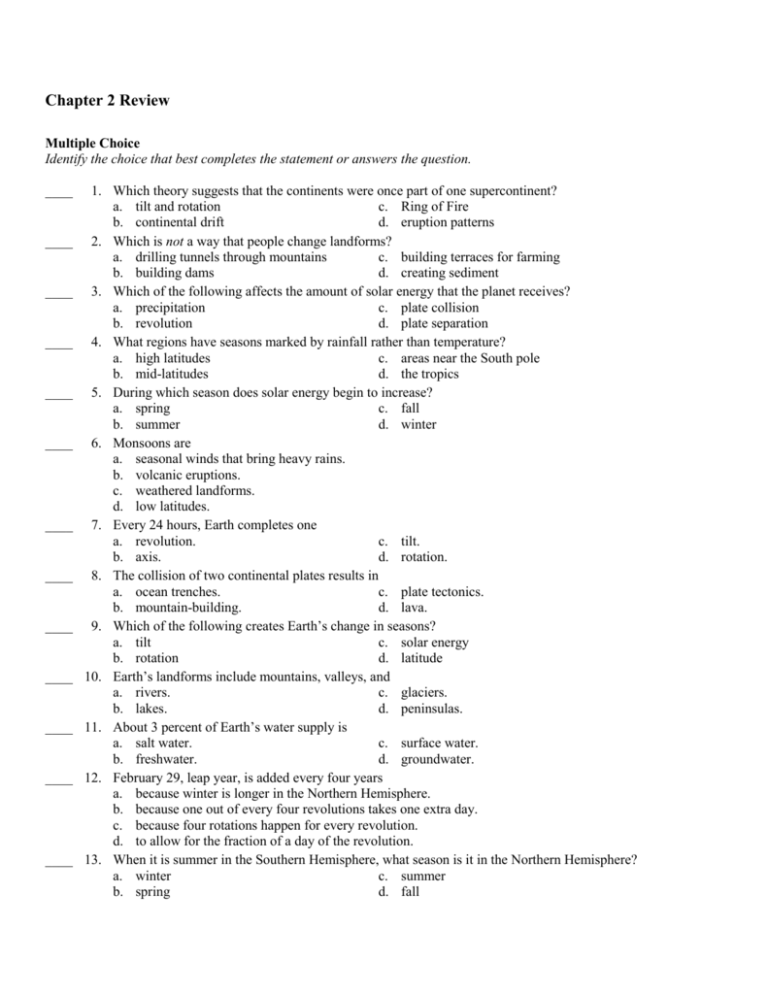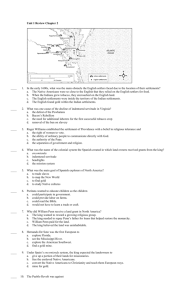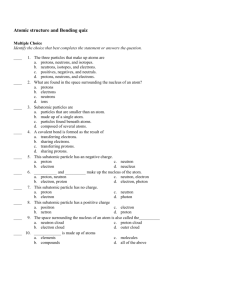Chapter 2 Review Multiple Choice Identify the choice that best
advertisement

Chapter 2 Review Multiple Choice Identify the choice that best completes the statement or answers the question. ____ ____ ____ ____ ____ ____ ____ ____ ____ ____ ____ ____ ____ 1. Which theory suggests that the continents were once part of one supercontinent? a. tilt and rotation c. Ring of Fire b. continental drift d. eruption patterns 2. Which is not a way that people change landforms? a. drilling tunnels through mountains c. building terraces for farming b. building dams d. creating sediment 3. Which of the following affects the amount of solar energy that the planet receives? a. precipitation c. plate collision b. revolution d. plate separation 4. What regions have seasons marked by rainfall rather than temperature? a. high latitudes c. areas near the South pole b. mid-latitudes d. the tropics 5. During which season does solar energy begin to increase? a. spring c. fall b. summer d. winter 6. Monsoons are a. seasonal winds that bring heavy rains. b. volcanic eruptions. c. weathered landforms. d. low latitudes. 7. Every 24 hours, Earth completes one a. revolution. c. tilt. b. axis. d. rotation. 8. The collision of two continental plates results in a. ocean trenches. c. plate tectonics. b. mountain-building. d. lava. 9. Which of the following creates Earth’s change in seasons? a. tilt c. solar energy b. rotation d. latitude 10. Earth’s landforms include mountains, valleys, and a. rivers. c. glaciers. b. lakes. d. peninsulas. 11. About 3 percent of Earth’s water supply is a. salt water. c. surface water. b. freshwater. d. groundwater. 12. February 29, leap year, is added every four years a. because winter is longer in the Northern Hemisphere. b. because one out of every four revolutions takes one extra day. c. because four rotations happen for every revolution. d. to allow for the fraction of a day of the revolution. 13. When it is summer in the Southern Hemisphere, what season is it in the Northern Hemisphere? a. winter c. summer b. spring d. fall ____ 14. If you were in the tropics, how would you know what season it was? a. the amount of rainfall c. the temperature b. the length of the days d. the rate of erosion ____ 15. If the poles are tilted neither toward nor away from the sun, which two seasons might it be? a. winter or fall c. spring or fall b. summer or spring d. summer or winter ____ 16. Earth’s tilt is the cause of a. night and day. c. latitude. b. the seasons. d. All of the above ____ 17. What can cause rock to break down into smaller pieces? a. daytime heating and nighttime cooling b. tree roots c. freezing water d. All of the above ____ 18. Mount Saint Helens, Hawaii, and the San Fernando Valley are all examples of a. mountains. c. plates. b. landforms. d. weathering. ____ 19. What happens when plates move apart? a. Lava emerges and forms a mid-ocean ridge. b. The plates begin to grind together. c. The plates collide again. d. Lava emerges and causes an earthquake. ____ 20. Which of the following landforms would not attract large settlements? a. a rich mineral deposit c. a river valley b. a harsh desert d. fertile farmland Completion Complete each statement. 21. Earthquakes often occur when two ____________________ slide past each other. (plates/landforms) 22. Most of Earth’s salt water is stored in ____________________. (wells/oceans) 23. The theory of ____________________ helps explain how forces below Earth’s surface have shaped our landforms. (plate tectonics/continental drift) 24. Earth’s ____________________ is an imaginary line around which it turns. (axis/latitude) 25. ____________________ is the most common cause of erosion. (Wind/Water) 26. The amount of time it takes Earth to complete one ____________________ is the basis for our calendar year. (rotation/revolution) 27. The Northern and Southern Hemispheres experience ____________________ seasons. (the same/opposite) True/False Indicate whether the statement is true or false. ____ 28. The Northern and Southern hemispheres experience summer at the same time. ____ 29. Rocks can break when water seeps into cracks and freezes. ____ 30. It takes Earth 354 days to make a trip around the sun. ____ 31. The water cycle is driven by energy from the sun. ____ 32. Earth’s surface is divided into about 12 slow-moving plates. Matching In the space provided, write the letter of the term that matches each description. a. the distance north or south of the equator b. water that is found in Earth’s streams, rivers, and lakes c. Earth’s yearly trip around the sun d. long periods of lower-than-normal precipitation e. the circulation of water from Earth’s surface to the atmosphere and back f. magma that reaches Earth’s surface g. large areas of slow-moving ice h. the process of breaking rock into smaller pieces i. one complete spin of Earth on its axis j. precipitation that flows over land into rivers and oceans ____ ____ ____ ____ ____ ____ 33. 34. 35. 36. 37. 38. revolution latitude weathering water cycle glacier rotation Short Answer 39. Why do certain parts of Earth receive warmer temperatures than others? 40. What causes the seasons in the Northern and Southern Hemispheres? 41. Explain why only a small percentage of Earth’s water is usable. 42. What causes the plates on Earth’s crust to move? Chapter 2 Review Answer Section MULTIPLE CHOICE 1. 2. 3. 4. 5. 6. 7. 8. 9. 10. 11. 12. 13. 14. 15. 16. 17. 18. 19. 20. ANS: ANS: ANS: ANS: ANS: ANS: ANS: ANS: ANS: ANS: ANS: ANS: ANS: ANS: ANS: ANS: ANS: ANS: ANS: ANS: B D B D A A D B A D B D A A C B D B A B PTS: PTS: PTS: PTS: PTS: PTS: PTS: PTS: PTS: PTS: PTS: PTS: PTS: PTS: PTS: PTS: PTS: PTS: PTS: PTS: 1 1 1 1 1 1 1 1 1 1 1 1 1 1 1 1 1 1 1 1 DIF: DIF: DIF: DIF: DIF: DIF: DIF: DIF: DIF: DIF: DIF: DIF: DIF: DIF: DIF: DIF: DIF: DIF: DIF: DIF: 1 1 1 1 1 1 1 1 1 1 1 2 2 2 2 2 1 2 1 2 COMPLETION 21. ANS: plates PTS: 1 22. ANS: oceans DIF: 1 NAT: 2.3.2 PTS: 1 DIF: 1 23. ANS: continental drift NAT: 2.2.1 PTS: 1 24. ANS: axis DIF: 1 NAT: 2.3.2 PTS: 1 25. ANS: water DIF: 1 NAT: 2.1.1 PTS: 1 26. ANS: revolution DIF: 1 NAT: 2.3.3 DIF: 1 NAT: 2.1.1 PTS: 1 NAT: NAT: NAT: NAT: NAT: NAT: NAT: NAT: NAT: NAT: NAT: NAT: NAT: NAT: NAT: NAT: NAT: NAT: NAT: NAT: 2.3.2 2.3.4 2.1.1 2.1.2 2.1.2 2.1.2 2.1.1 2.3.2 2.1.2 2.3.1 2.2.1 2.1.1 2.1.2 2.1.2 2.1.2 2.1.2 2.3.3 2.3.1 2.3.2 2.3.4 27. ANS: opposite PTS: 1 DIF: 1 NAT: 2.1.2 F T F T T PTS: PTS: PTS: PTS: PTS: 1 1 1 1 1 DIF: DIF: DIF: DIF: DIF: 1 1 1 1 1 NAT: NAT: NAT: NAT: NAT: 2.1.2 2.3.3 2.1.1 2.2.2 2.3.2 C A H E G I PTS: PTS: PTS: PTS: PTS: PTS: 1 1 1 1 1 1 DIF: DIF: DIF: DIF: DIF: DIF: 1 1 1 1 1 1 NAT: NAT: NAT: NAT: NAT: NAT: 2.1.1 2.1.1 2.3.3 2.2.2 2.3.3 2.1.1 TRUE/FALSE 28. 29. 30. 31. 32. ANS: ANS: ANS: ANS: ANS: MATCHING 33. 34. 35. 36. 37. 38. ANS: ANS: ANS: ANS: ANS: ANS: SHORT ANSWER 39. ANS: Places tilting toward the sun and places at lower latitudes experience warmer temperatures. PTS: 1 DIF: 2 NAT: 2.1.1 40. ANS: Earth’s tilt. As the North Pole tilts toward the sun in summer, the South pole tilts away from it. As a result the Southern Hemisphere experiences winter. PTS: 1 DIF: 2 NAT: 2.1.2 41. ANS: About 97% of Earth’s water is salt water. Much of the world’s freshwater is locked in glaciers. Students might also mention that some water is difficult to obtain or polluted. PTS: 1 DIF: 2 NAT: 2.2.1 42. ANS: Energy deep inside the planet puts pressure on Earth’s crust. As this pressure builds up, it forces the plates to shift. PTS: 1 DIF: 2 NAT: 2.3.2








